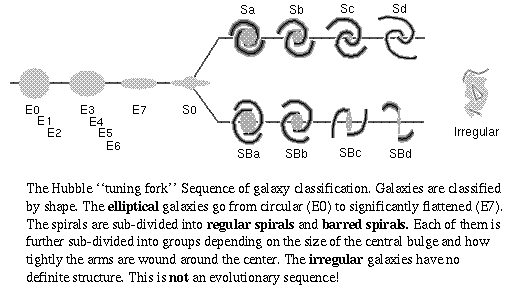
This material (including images) is copyrighted!. See my copyright notice for fair use practices. Select the photographs to display the original source in another window. Most of the ground-based telescope pictures here are from the Anglo-Australian Observatory (AAO---used by permission). Links to external sites will be displayed in another window.
Edwin Hubble divided the galaxies into three basic groups based on their appearance: ellipticals, spirals, and irregulars. The ellipticals are smooth and round or elliptical, the spirals are flat with a spiral pattern in their disk, and the irregulars have stars and gas in random patches. Most galaxies are small and faint so only the luminous galaxies are seen at great distances. These spectacular galaxies tend to be either the elliptical or spiral type, so they are the ones often displayed in astronomy textbooks.
In 1936 Hubble put these groups onto a two-pronged sequence that looks like a tuning fork because he thought that the galaxies started out as ellipticals, then changed to spirals and then to irregulars. In this scenario, a galaxy could take one of two paths. It could take the top prong and be a regular spiral where the arms come right out of the galaxy center, or it could take the bottom prong and be a barred spiral with the arms starting from the ends of a bar of gas and stars going through the center. The ellipticals are sub-divided by how round they are and the spirals are sub-divided by how loose their arms are and how big their nucleus is.

Astronomers now know that it is NOT an evolutionary sequence because each type of galaxy has very old stars. The oldest stars in any galaxy all have about the same age of around 13 billion years. This means that spirals form as spirals, ellipticals form as ellipticals, and irregulars form as irregulars. However, the ``tuning fork'' diagram is still used to classify galaxies because of its convenience.
Elliptical galaxies are sub-classified according to how flat they are. The number next to the ``E'' in the tuning fork diagram = 10×(largest diameter - smallest diameter) / (largest diameter), so an E7 galaxy is flatter than an E0 galaxy. The flattened shape is not due to rotational flattening but to how the orbits are oriented and the distribution of the star velocities. Most ellipticals are small and faint. The dwarf ellipticals may be the most common type of galaxy in the universe (or maybe the dwarf irregulars are). Small galaxies classified as "dwarf spheroidals" are even fainter than most dwarf ellipticals but dwarf spheroidals may be just a continuation of dwarf ellipticals to smaller sizes and they can have as little as just a few hundred stars. Examples of elliptical galaxies are M32 (an E2 dwarf elliptical next to the Andromeda Galaxy) and M87 (a huge elliptical in the center of the Virgo cluster). The image sequence below starting from from top left and moving clockwise: Messier 32 (E2 satellite of Andromeda Galaxy), Messier 87 (a huge elliptical at the center of the Virgo cluster), Leo I (=UGC 5470, E3 dwarf elliptical in Local Group), Messier 110 (another satellite of Andromeda Galaxy, E6 type)
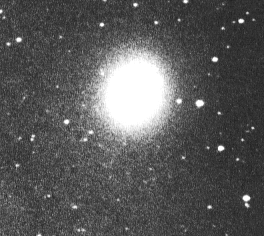 Messier 32: a dwarf elliptical (E2) satellite galaxy of the Andromeda Galaxy. Courtesy of NOAO/AURA/NSF |
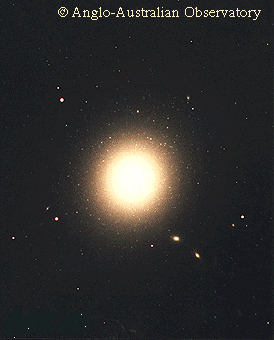 Messier 87: giant elliptical (E1) at the Virgo Cluster's core. It has grown very large by ``eating'' other galaxies. |
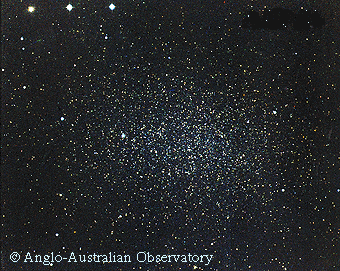 Leo I: dwarf elliptical (E3) in the Local Group. |
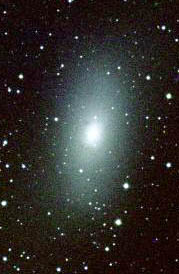 Messier 110: dwarf elliptical (E6) satellite galaxy of the Andromeda Galaxy. Courtesy of Bill Schoening, Vanessa Harvy/REU program/NOAO/AURA/NSF --- cropped from their M 31 image)) |
![]() Go back to previous section --
Go back to previous section --
![]() Go to next section
Go to next section
last updated: June 28, 2022